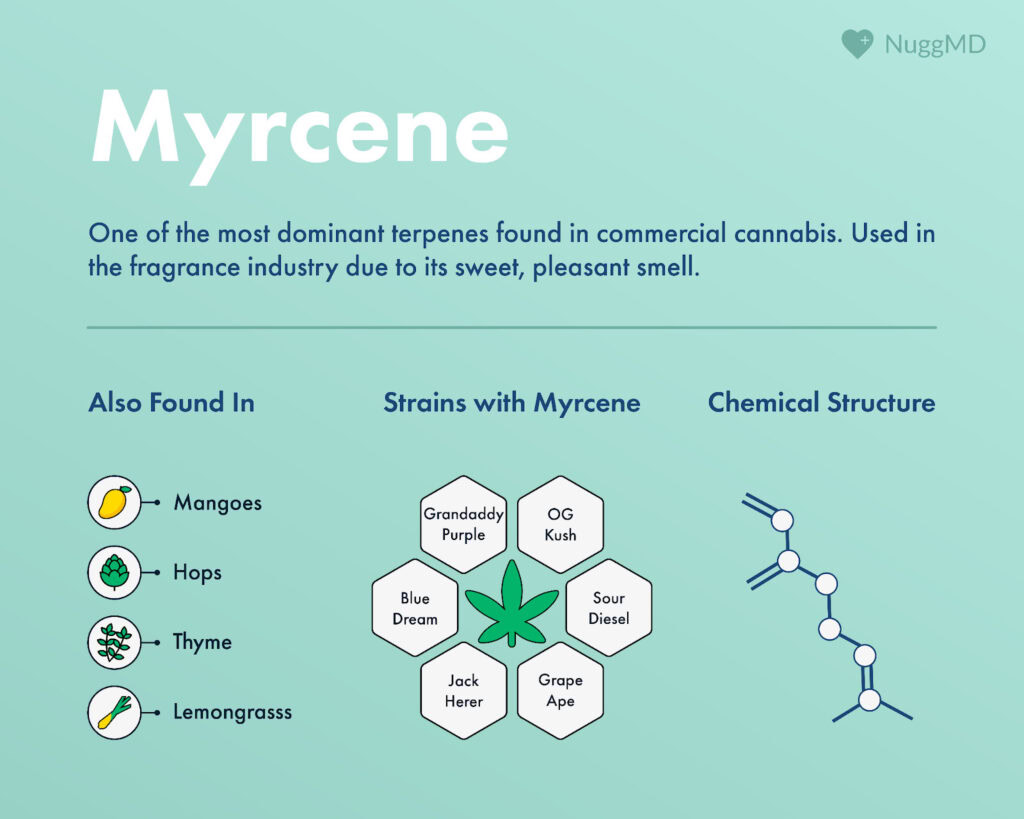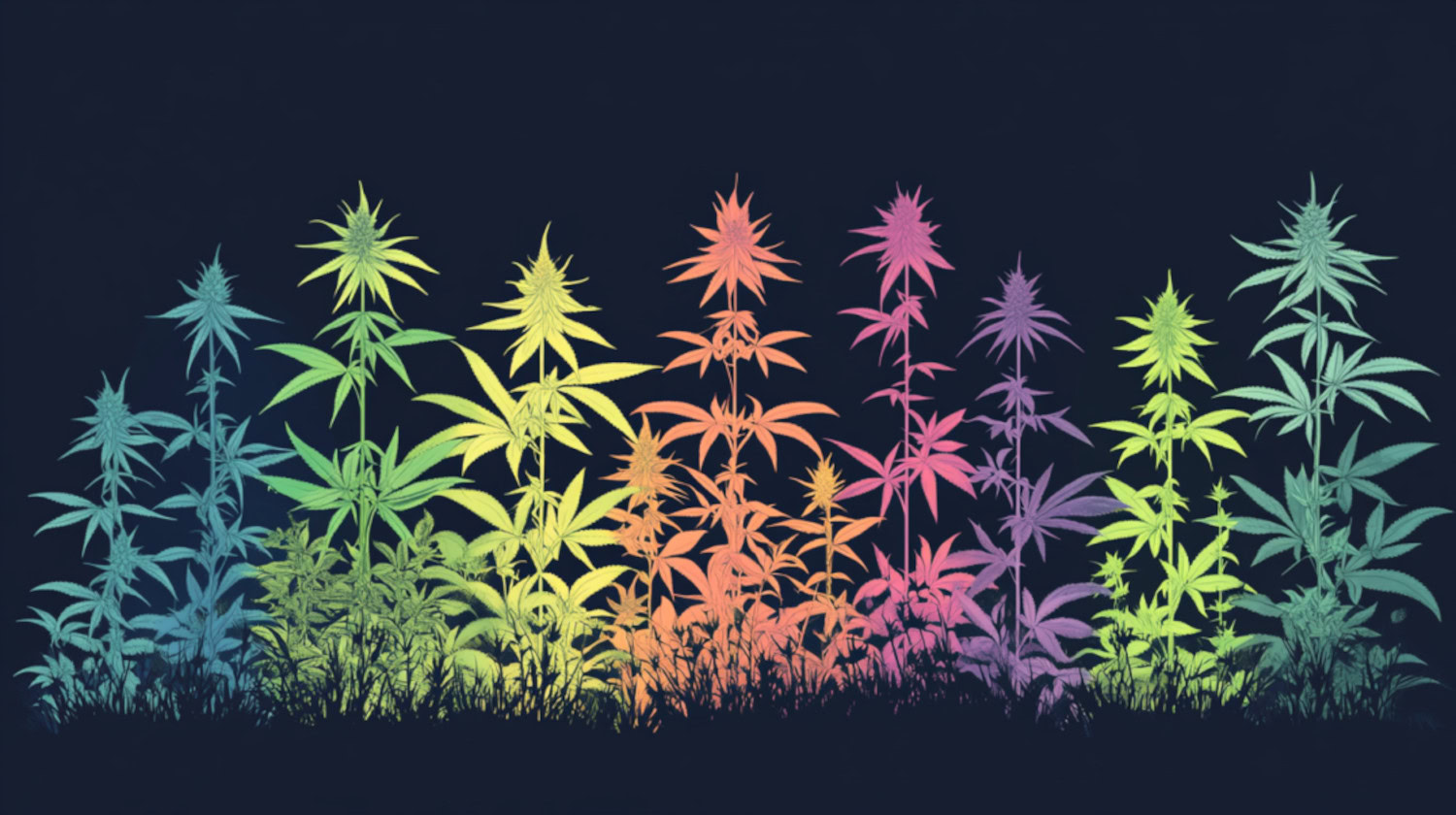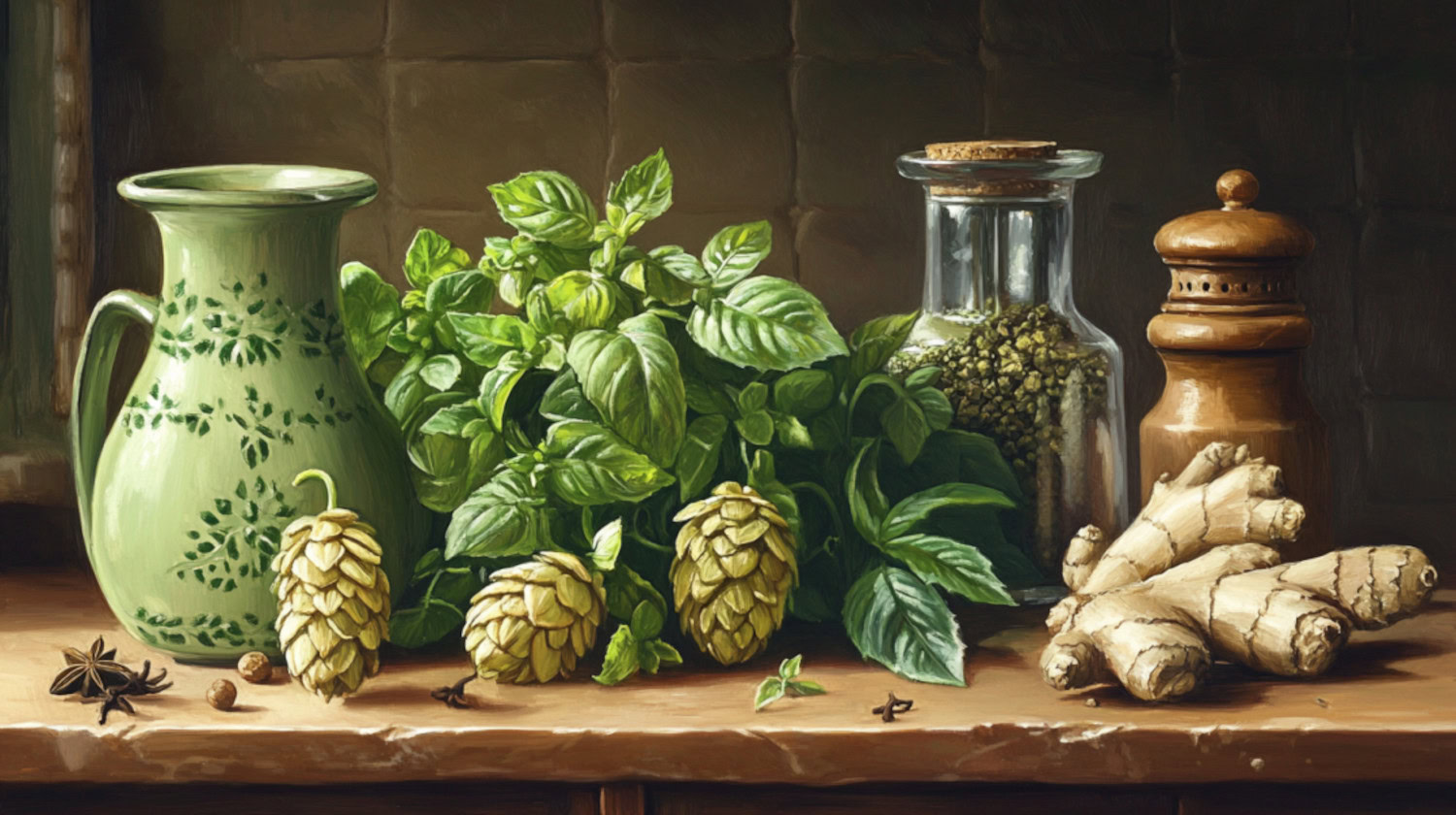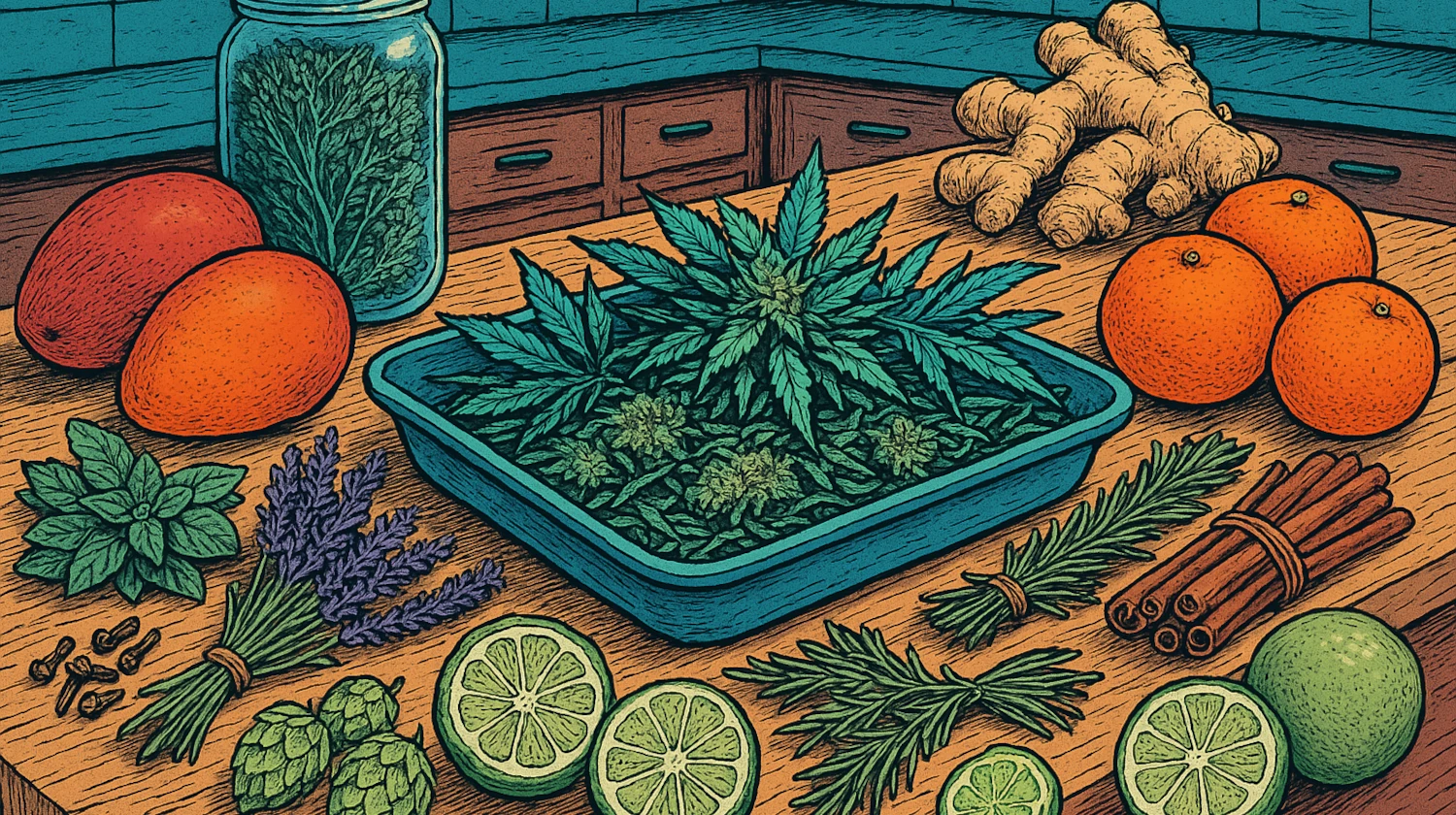Key Takeaways
- The myrcene terpene is commonly found in cannabis, often associated with earthy, musky aromas and calming influences.
- Its presence in specific strains may contribute to soothing effects, enhanced flavor, and potential wellness benefits.
- For high myrcene strains, check out Jack Herer, Graddaddy Purple, and Sour Diesel.
Terpenes are the aromatic compounds found in all plants, including cannabis. Alongside flavorants, they are crucial in determining a cultivar’s taste, aroma, and overall effect.
Myrcene, a primary terpene in numerous strains, stands out for its earthy notes and mild sedative qualities. Such effects make it a favorite among many cannabis consumers.
What is Myrcene?
Terpenes are organic compounds found in all plants, including cannabis. Plants use terpenes, such as myrcene and thousands of others, to protect themselves and attract organisms that are beneficial to their survival and growth.
Myrcene, sometimes referred to as beta myrcene, is considered one of the most prominent terpenes in cannabis. It also appears in herbs, essential oils, and spices like hops, lemongrass, bay leaves, and citrus fruits. In cannabis, myrcene commonly shows up in moderate to high amounts, potentially contributing to an herbal, musky, or subtly sweet aroma.1
Much like how limonene delivers a bright citrus element, or linalool imparts a lavender-like note, myrcene often lends an earthy, occasionally pungent note to a strain.
The synergy among these terpenes and the plant’s other compounds is called the entourage effect. It suggests no single component defines a strain’s taste, smell, or potential effects. Instead, the experience of the collective compounds makes each unique and noteworthy.
While the public largely accepts the entourage effect, research into its validity remains ongoing.
What Does Myrcene Smell Like?

Myrcene contributes to a range of scents, ranging from earthy and herbaceous to slightly sweet and balsamic.1 Beer enthusiasts, particularly craft brew fans, might recognize myrcene in the previously mentioned hops.
Within cannabis, a terpene like myrcene may add many signature smells and flavors to a strain, such as:
- Herbal Musk: Aromatic notes that often resemble nature, such as a lush, damp forest floor.
- Sweet and Fruity: Subtle tropical and/or mild sweet notes can be found in certain cultivars.
- Resinous: Some strains are known to produce a “sticky” type of mouthfeel.
Myrcene can produce a variety of signature notes and flavors. It typically delivers mildly sweet, tangy notes similar to tropical fruit juice.
Effects and Benefits of Myrcene

Myrcene’s aromatic molecules play a notable role in the consumer experience, mainly contributing to the experience of an untold number of strains. The terpene has become linked to various potential medical benefits.
Some findings suggest that myrcene may deliver several favorable effects for medical consumers, such as:1
- Sedative: Often linked to calming, tranquil sensations.
- Mild Analgesic: Largely anecdotal reports suggest that myrcene may produce minor physical relief.
- Antioxidant and Anti-Inflammatory: Human studies have been scant, but possible protective effects have been reported.
- Anticonvulsant: Early research has explored myrcene’s role in seizure reduction, with most analyses currently conducted on non-human models.
- Antidiabetic, Antibacterial, and Anticancer: Preliminary investigations in animals or cell cultures highlight potential benefits. But, few human trials have been performed.
Most reported effects of myrcene come from animal, in vitro, or essential oil inhalation studies.
What Other Plants Contain Myrcene?

Beta myrcene is not exclusive to cannabis. Substantial amounts of this terpene can be found in numerous botanicals, including but not limited to:
- Hops (Humulus lupulus): Myrcene is one of the most potent aromatic flavor components in brewing, forming up to 70% of hop’s essential oil.1
- Lemongrass (Cymbopogon citratus): Known for its citrus tang, lemongrass also showcases subtle myrcene-driven herbal notes. Furthermore, select research has tied myrcene to antibacterial, antifungal, and antiviral capabilities.2
- Bay Leaves (Laurus nobilis): Often used for their pungent, savory qualities in cooking, bay leaves include myrcene, which may help address symptoms of diabetes or cardiovascular concerns.3
- Citrus Fruits: Oranges and related varieties may contain trace amounts of myrcene, which adds a subtle sweetness to a citrus-rich profile.1
What Conditions Can Myrcene Help With?
Initial research into myrcene and terpenes joins long-running consumer anecdotes, helping connect the compound to possible beneficial effects, including:
- Mild sedation
- Stress relief
- Potential mood improvement
Based on the reported benefits, cannabis consumers may find relief in high-myrcene strains, potentially addressing conditions and symptoms related to:
- Stress
- Anxiety
- Sleep difficulties
- Mild mood imbalances
- Minor physical discomfort
While these claims are common among consumers, clinical studies remain limited. As such, claims about pure myrcene’s effect on humans are considered inconclusive. Still, scores of consumers insist that compounds like myrcene deliver positive effects.
It is recommended that anyone interested in using myrcene for medical purposes should first consult with a trusted physician. Doing so helps the patient best understand their unique situation and how cannabis compounds may impact them.
Best Strains for the Myrcene Terpene

Strain selections are personal choices, with each person experiencing cannabis strains differently. Additionally, while some strains often test high in myrcene, their actual terpene percentages differ across growing conditions and phenotype variations–making terpene content vary from yield to yield.
Anyone seeking a myrcene-rich strain backed by numerous positive consumer reports may want to check out the following cultivars:
- Jack Herer: Often associated with an uplifting yet balanced profile. Myrcene's presence may underline its slightly earthy, pine-forward aroma.
- Grape Ape: A proper purple strain known for its sweet, grape-like notes and potentially sedative properties.
- Granddaddy Purple: Beloved for its candy-sweet grape aroma and relaxing nature, boosted by moderate myrcene content in many cuts.
- Blue Dream: A hybrid recognized for a smooth, berry-infused flavor. Myrcene occasionally appears in moderate quantities, contributing to this strain’s balanced effects.
- Sour Diesel: A pungent, fuel-like scent with myrcene infusing this iconic strain with a lightly herbal twist, complimenting its energetic effects.
References
- Surendran S, Qassadi F, Surendran G, Lilley D, Heinrich M. Myrcene—What Are the Potential Health Benefits of This Flavouring and Aroma Agent? Frontiers in Nutrition. 2021;8. doi:https://doi.org/10.3389/fnut.2021.699666 ↩︎
- Mukarram M, Choudhary S, Khan MA, Poltronieri P, Khan MMA, Ali J, Kurjak D, Shahid M. Lemongrass Essential Oil Components with Antimicrobial and Anticancer Activities. Antioxidants. 2022; 11(1):20. https://doi.org/10.3390/antiox11010020 ↩︎
- Singletary K. Bay Leaf. Nutrition Today. 2021;56(4):202-208. doi:https://doi.org/10.1097/nt.0000000000000493 ↩︎
The information in this article and any included images or charts are for educational purposes only. This information is neither a substitute for, nor does it replace, professional legal advice or medical advice, diagnosis, or treatment. If you have any concerns or questions about laws, regulations, or your health, you should always consult with an attorney, physician or other licensed professional.




